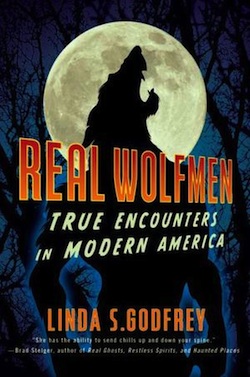The book Real Wolfmen: True Encounters in Modern America (Penguin Books, 2012) by Linda S. Godfrey is now out, and it makes an interesting contribution to the study of cryptozoology, as well as horror and culture. Following is an excerpt:
The U.S. has been invaded – if many dozens of eyewitnesses are to be believed – by upright, canine creatures that look like traditional werewolves and act as if they own our woods, fields, and highways. Sightings from coast to coast dating back to the 1930s compel us to ask exactly what these beasts are, and what they want.
Researcher, author and newspaper reporter Linda S. Godfrey has been tracking the manwolf since the early 1990. In Real Wolfmen she presents the only large-scale cataloguing and investigation of reports of modern sightings of anomalous, upright canids. First-person accounts from Godfrey’s witnesses – who have encountered these creatures everywhere from outside their car windows to face-to-face on a late night stroll – describe the same human-sized canines: They are able to walk upright and hold food in their paws, interact fearlessly with humans, and suddenly and mysteriously disappear.
Godfrey explores the most compelling cases from the modern history of such sightings, along with the latest reports, and undertakes a thorough exploration of the nature and possible origins of the creature.
Introduction
The Canid InvasionDo true, shape-shifting werewolves exist in the modern world—or are the woods, fields, and highways of the United States infested with creatures that merely look like the legendary canine monsters? According to scores of sober, credible eyewitnesses, creatures resembling wolfmen do walk among us! Scary old tales of werewolves and other man-animals have lurked amid the folklore of cultures worldwide ever since the campfire was invented. Ancient denizens of the British Isles believed competing clans transformed themselves into wolves in order to attack livestock. Europeans of the Middle Ages kept a sharp eye out for those who showed signs—like hairy palms or unusual moles—of having made pacts with the devil to become werewolves. Many Native American tribes believed certain medicine men could manifest animal forms to go forth and perform malign deeds. The wolflike Navajo skin walker is probably the best-known example of such lore.
But based on today’s largely rationalistic view of the world, many tend to pooh-pooh the possibility that such frightening creatures could truly exist. We like our monsters safely pasted on the silver screen or caged in the confines of a game console. During the last few decades, werewolves have become increasingly commonplace in movies, TV shows, and hyperreal video games. Werewolves playing a starring role in the 1985 flick Silver Bullet, based on Stephen King’s Cycle of the Werewolf, or in the 2007 episode of the TV show Supernatural that featured a murderous lycanthrope, are great fun because they remain under glass, living on only in our imaginations.
It was a shock to the collective psyche in January 1992, then, when headlines slashed through worldwide media heralding werewolf sightings in Elkhorn, Wisconsin. Citizens of the small town, located about half an hour’s drive from Beloit on the Illinois border, claimed to have seen a six-foot-tall, fur-covered creature complete with muzzle, pointy ears, and fangs lurking on a rural two-mile stretch called Bray Road. Such monsters may be everywhere in our entertainment world, but their sudden appearance in densely populated regions of America’s Dairy Land was stunning, even to a public already used to eyewitness reports of UFOs and Bigfoot.
I wrote the original news story “The Beast of Bray Road” for the December 31, 1991, issue of The Week, a paper that covered events in Walworth County. A less adventuresome publication might have ignored the reports entirely. But as a newly hired reporter, I was at once skeptical and intrigued. Elkhorn is a rather conservative little community whose citizens are not usually given to weird proclamations. It bills itself as “The Christmas Card Town” because its picturesque square was once the subject of a series of popular greeting cards, and it functions as the county seat of government. Unknown, hairy creatures were not something anyone could recall in the town’s entire history. The Week’s newsroom staff had a good laugh over the whole idea of werewolves, but since I was curious, the editor finally told me to see what I could learn about it.
I had never even heard the term “cryptozoology”—the study of unknown animals—at the time, but these sightings promised an enticing mystery to be solved. At the very least, I thought people had the right to know if a dangerous animal was in the area. I was not the only person thinking that way.
In my initial investigation I found that people had been calling the county’s animal control officer, Jon Fredrickson, to ask what the strange creature they had seen could possibly be. Some of the reports to Fredrickson involved multiple eyewitnesses, so that my first count of people who officially claimed to have seen a large, mysterious canine totaled at least eight.
My next step was to visit Fredrickson at his office, where he pulled a manila file folder from a drawer. The folder was labeled “Werewolf.” As I have said many times since, when a county official has an active file folder marked “werewolf,” that’s news. Armed with only a notebook, a pen, and a driving need to solve the puzzle, I began the wild hunt.
You can read more at TOR.com.






There are no responses yet